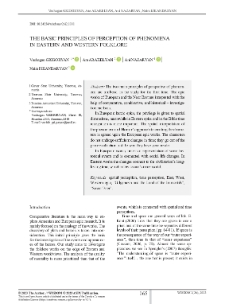Նիւթ
Վերնագիր: The Basic Principles of Perception of Phenomena in Eastern and Western Folklore
Journal or Publication Title:
Date of publication:
Volume:
Number:
ISSN:
Corporate Creators:
Խ․ Աբովյանի անվան հայկական պետական մանկավարժական համալսարան
Coverage:
Abstract:
The two main principles of perspective of phenomena are analyzed in the study for the first time. The epic works of European and the Near East are interpreted with the help of comparative, combinative, and historical –investigation methods. In European heroic epics, the privilege is given to spatial dimensions, meanwhile in Eastern epics and in the Bible time recognition is more important. The spatial interpretation of the phenomena and Homer‟s approach to creating the characters is spread upon the European epic works. The characters do not undergo sufficient changes in time; they go out of the process of action just the way they have gone inside. In European works, time is a representation of some his-torical events and is connected with social life changes. In Eastern works the changes connect to the civilization‟s long-lasting time, which refers to one‟s inner world.
Place of publishing:
Երևան
Publisher:
Format:
Identifier:
oai:arar.sci.am:372370
Language:
Նիւթին հաւաքածոները:
Վերջին անգամ ձեւափոխուած է:
Oct 8, 2025
Մեր գրադարանին մէջ է սկսեալ:
Apr 4, 2024
Նիւթին բովանդակութեան հարուածներուն քանակը:
56
Նիւթին բոլոր հասանելի տարբերակները:
https://arar.sci.am/publication/402295
Ցոյց տուր նկարագրութիւնը RDF ձեւաչափով:
Ցոյց տուր նկարագրութիւնը OAI-PMH ձեւաչափով։
-
Իմաստություն=Wisdom=Мудрость
-
Իմաստություն, 2013, N 1
-
Իմաստություն, 2014, N 1 (2)
-
Իմաստություն, 2014, N 2 (3)
-
Իմաստություն, 2015, N 1 (4)
-
Wisdom, 2015, N 2 (5)
-
Wisdom, 2016, N 1 (6)
-
Wisdom, 2016, N 2 (7)
-
Wisdom, 2017, N 1 (8)
-
Wisdom, 2017, N 2 (9)
-
Wisdom, 2018, N 1 (10)
-
Wisdom, 2018, N 2 (11)
-
Wisdom, 2019, N 1 (12)
-
Wisdom, 2019, N 2 (13)
-
Wisdom, 2020, N 1 (14)
-
Wisdom, 2020, N 2 (15)
-
Wisdom, 2020, N 3 (16)
-
Wisdom, 2021, N 1 (17)
-
Wisdom, 2021, N 1 (1) Special issue
-
Wisdom, 2021, N 2 (18)
-
Wisdom, 2021, N 3 (19)
-
Wisdom, 2021, N 4 (20)
-
Wisdom, 2022, N 1 (21)
-
Wisdom, 2022, N 1 (2) Special issue
-
Wisdom, 2022, N 2 (22)
-
Wisdom, 2022, N 2 (3) Special issue
-
Wisdom, 2022, N 3 (23)
-
Wisdom, 2022, N 3 (4) Special issue
-
Wisdom, 2022, N 4 (24)
-
Wisdom, 2023, N 1 (25)
-
Wisdom, 2023, N 2 (26)
- Editorial board
- Contents
- Editor`s Foreword
- An Аxiomatic System of Philosophical Ontology
- The Problem of the Subject and Object of Cognition in Postnonclassical Science
- Coalitions as a Factor in the Institutionalization of the Transition to Democracy
- The Denotation of Socio-Political Infantilism in the Context of RA Democratization
- Vocation: Theory and Practice
- Psychological Study of the Environmental Factors of Personal Creativity Manifestation
- Concept of Public Administration in the Context of Globalization
- Formation of Thought Style in Organizing the Educational Process and Training of Medical Students
- Pedagogical Potential of the Philosophy of Atheistic Existentialism and Humanistic Psychoanalysis
- Evaluation Model for Virtue Education in Business English Courses
- Islamic Nomocracy: Muhammadiyah‟s Philosophy on the Relationship Between Religion and the State in Indonesia
- Liberalism and Religious Moderation: The Dilemma in Indonesia
- Raphael's “The School of Athens”: A Hypothesis on the Identity and Symbolic Meaning of the Figure in White Cloak: The True Muse of Raphael
- The Associative Characteristics of Linguophilosophical Concept “Freedom” in English, Armenian and Chinese Linguocultures
- The Basic Principles of Perception of Phenomena in Eastern and Western Folklore
- A Linguistic-Pragmatic Study on Collocations in Business Media Discourse
- Syntactic Stylistic Devices of Speech Manipulation in the English-Language Lifestyle Media Discourse
- Human Rights and Freedoms: Ensuring a Balance of Public Interests
- Methodological Foundations of Socio-Philosophical and Legal Analysis of Corruption
- The Liability of Corporate Governance Bodies as a Philosophical-Legal Category
- The Impact of Behaviorist Theories and the Legal System Laws Developed from Them
- The Philosophical Thought of the Prophetic Law in the Indonesian Legal System
- Сoncept of Alienation in the Works of K. Marx and J. Baudrillard
- Notes to Contributors
-
Wisdom, 2023, N 3 (27)
-
Wisdom, 2023, N 4 (28)
-
Wisdom, 2024, N 1 (29)
-
Wisdom, 2024, N 2 (30)
-
Իմաստություն, 2013, N 1
| Հրատարակութեան անունը | Թուական |
|---|---|
| Grigoryan, Vachagan, The Basic Principles of Perception of Phenomena in Eastern and Western Folklore | Oct 8, 2025 |





